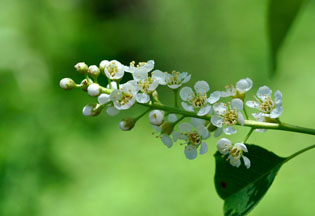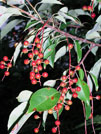BLACK CHERRY
|
 |
| File Size: 69 KB |
|
|
|
Prunus serotina Ehrh.
|
| Johnson County, Kansas |
| Height: Trees, to 70 feet |
| Family: Rosaceae - Rose Family |
| Flowering Period: April, May |
|
| Also Called: | | Rum cherry. | | Trunks: | | Trunk erect; bark reddish brown to blackish brown, eventually fissured with blocky plates; wood reddish brown, hard. | | Twigs: | | Reddish brown, flexible, usually glabrous, sometimes minutely pubescent; leaf scars elliptic; buds brown, ovoid, .12 to .2 inch, apex acute, scales glabrous. | | Leaves: | | Deciduous, alternate, simple; stipules caducous, lanceolate, .16 to .3 inch, margins glandular-toothed; petiole .4 to .8 inch, usually glabrous, sometimes sparsely minutely pubescent, with 1-6 glands distally; blade lanceolate to oblong or oblanceolate, 1.6 to 5.2 inches long, .8 to 2.3 inches wide, base obtuse to truncate, margins crenulate-serrulate to serrulate, teeth incurved or appressed, apex acute to acuminate, lower surface light green, usually glabrous, sometimes with tufts of hairs along midrib, upper surface dark green, glabrous. | | Flowers: | | Inflorescences terminal on short shoots, racemes, 20-50(-100)-flowered, 1.6 to 5.6 inches, appearing after leaves; peduncles .2 to 2.8 inches, glabrous; pedicels .12 to .24 inch, glabrous. Flowers bisexual, radially symmetric, .28 to .4 inch diam.; hypanthium bell-shaped, .04 to .07 inch, glabrous; sepals 5, spreading, triangular to oblong, to .05 inch long, margins entire or glandular-erose; petals 5, white, ovate to nearly round, .1 to .16 inch; stamens (15-)20; pistil 1, ovary superior, 1-locular, glabrous; style .05 to .07 inch; stigma capitate. | | Fruit: | | July-August; drupes, dark purple, nearly spherical, .3 to .5 inch, glabrous, not glaucous; hypanthium persistent beneath drupe as a lobed or fringed disk; stone 1, tan to light brown, nearly spherical, .2 to .28 inch long, .16 to .24 inch wide, surface more or less smooth. | | Habitat: | | Floodplain and mesic upland forests, stream banks, fencerows, edges of woodlands. | | Distribution: | | East 1/2 of Kansas | | Origin: | | Native | | Toxicity: | | In Poisonous Plants of the United States, Kingsbury stated that black cherry is one of the most dangerous of the wild cherries in eastern North America. The leaves and stones, which contain cyanogenic glycosides, are reported to have caused poisoning in cattle and humans when consumed. | | Uses: | | The wood is valued for its fine grain and reddish-brown color; it is used to manufacture paneling, furniture, cabinets, and many specialty and hobby items. Many Native American tribes in eastern North America prepared infusions, decoctions, or poultices from the bark, roots, or fruits to treat a range of ailments, and the fruits were an important source of food and beverage. | | Comments: | | Prunus serotina is a characteristic tree of mesic forests in eastern North America. It is also a common early successional species in disturbed woodlands, forests, and open habitats. Prunus serotina is a highly variable species. Kansas plants all belong to the widespread var. serotina. |
|
| Black cherry habit |  | | 144 KB | | Johnson County, Kansas |
| | Black cherry bark |  | | 154 KB | | Johnson County, Kansas |
| | Black cherry buds |  | | 54 KB | | Johnson County, Kansas |
| | Black cherry leaves |  | | 65 KB | | Johnson County, Kansas |
| | Black cherry flowers |  | | 53 KB | | Johnson County, Kansas |
| | Black cherry leaves |  | | 76 KB | | Johnson County, Kansas |
| | Black cherry fruit |  | | 147 KB | | Craig Freeman photo |
| | | |
|
|
|